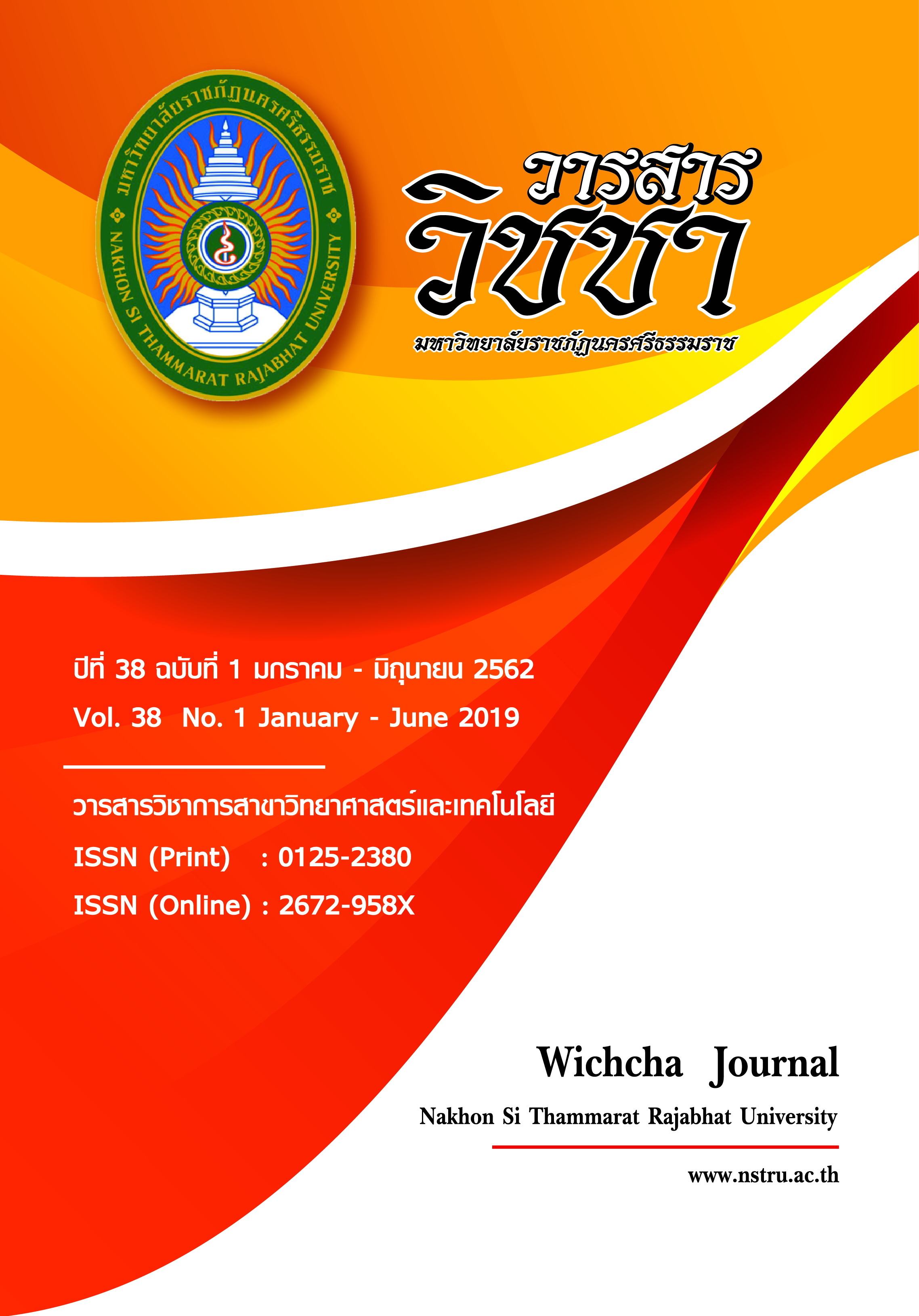Plastic Types and Usage by People in Nakhon Si Thammarat Rajabhat University Area, Nakhon Si Thammarat Province
Main Article Content
Abstract
Plastic accumulation or pollution is increasing day by day. Plastics can absorb and transport chemical pollutants and thus create chemical pollution. Plastic pollution is a threat to creatures on lands and in oceans. It is important to investigate and be knowledgeable about plastic usage before plastic pollution management in a particular area. This study investigates (1) the types of discarded plastic products inside the dustbins to know the plastic accumulation in the environment, and (2) plastic usage by people in Nakhon Si Thammarat Rajabhat University area, Nakhon Si Thammarat Province, southern Thailand. People were categorized based on their sex (males and females), age-groups (young and old), and occupations (students, office employees, cleaners, Songtaew drivers, housewives, and sellers). The results showed that dustbins contained eight types of plastic products (plastic bags, boxes, spoons, glasses, bottles, straws, food packages, and styrofoams) and the number of plastic bags was the highest (p < 0.05). Between males and females, males used significantly more plastic boxes, spoons, glasses and straws than females (p < 0.05). Between young and old people, old people used significantly more styroforms, boxes, glasses and plastic bags than young people (p < 0.05). Among people from different occupations, office employees used significantly more styrofoams, glasses, and straws; students, cleaners and drivers consumed significantly more packaged foods; cleaners and housewives used significantly more plastic bags; and cleaners used significantly more boxes and spoons, compared to other occupational groups (p < 0.05). This study shows that people from different sexes, age-groups, and occupations use plastics differently in their everyday life, and their daily consumption behaviors might shape their plastic usage. The findings of this study are very new as nobody has yet addressed how people from different ages, sexes and occupations use plastics in their everyday life in southern Thailand.
Article Details
เนื้อหาและข้อมูลในบทความที่ลงตีพิมพ์ในวารสารวิชชา มหาวิทยาลัยราชภัฏนครศรีธรรมราช ถือเป็นข้อคิดเห็นและความรับผิดชอบของผู้เขียนบทความโดยตรง ซึ่งกองบรรณาธิการวารสารไม่จำเป็นต้องเห็นด้วยหรือร่วมรับผิดชอบใด ๆ
บทความ ข้อมูล เนื้อหา รูปภาพ ฯลฯ ที่ได้รับการตีพิมพ์ในวารสารวิชชา มหาวิทยาลัยราชภัฏนครศรีธรรมราช ถือเป็นลิขสิทธ์ของวารสารวิชชา มหาวิทยาลัยราชภัฏนครศรีธรรมราช หากบุคคลหรือหน่วยงานใดต้องการนำข้อมูลทั้งหมดหรือส่วนหนึ่งส่วนใดไปเผยแพร่ต่อหรือเพื่อการกระทำการใด ๆ จะต้องได้รับอนุญาตเป็นลายลักษณ์อักษรจากวารสารวิชชา มหาวิทยาลัยราชภัฏนครศรีธรรมราชก่อนเท่านั้น
The content and information in the article published in Wichcha journal Nakhon Si Thammarat Rajabhat University, It is the opinion and responsibility of the author of the article. The editorial journals do not need to agree. Or share any responsibility.
References
Besseling, E., Foekema, E.M., Franeker, J.A.V., Leopold, M.F., Kühn, S., Rebolledo, E.L.B, Heße, E., Mielke, L., IJzer, J., Kamminga, P. and Koelmans, A.A. (2015). Microplastic in a macro filter feeder: humpback whale Megaptera novaeangliae. Marine Pollution Bulletin, 95(1), 248-252.
Chang, M. (2015). Reducing microplastics from facial exfoliating cleansers in wastewater through treatment versus consumer product decisions. Marine Pollution Bulletin, 101(1), 330-333.
Gourmelon, G. (2015). Global plastic production rises, recycling lags. New Worldwatch Institute analysis explores trends in global plastic consumption and recycling. Retrieved 10 December 2017, from: https://www. worldwatch. org.
Jambeck, J.R., Geyer, R., Wilcox, C., Siegler, T.R., Perryman, M., Andrady, A., Narayan, R. and Law, K.L. (2015). Plastic waste inputs from land into the ocean. Science, 347(6223), 768-771.
Leallaphan, A. and Launglaor, W. (2015). Attitudes and behavior of Bangkok Residents regarding reducing the use of plastic bags. University of the Thai Chamber of Commerce Journal, 34 (1), 70-87.
Lee, K. (2009). Gender differences in Hong Kong adolescent consumers' green purchasing behavior. Journal of Consumer Marketing, 26(2), 87-96.
Lynn, H., Rech, S. and Samwel, M. (2016). Plastics, gender and the environment. Life cycle of plastics and its impacts on women and men from production to (marine) litter. Netherlands: Women Engage for a Common Future International.
Martinsons, M.G., So, S.K., Tin, C. and Wong, D. (1997). Hong Kong and China: emerging markets for environmental products and technologies. Long Range Planning, 30(2), 277-156.
Matichon online. (2017). Nakhon Si Thammarat - waste water overflowing the city stinking smell after another heavy flood, the public complained of dreaded epidemics. Retrieved 26 February 2017, from: https://www. matichon.co.th/ local/news_439040.
Napper, I.E., Bakir, A., Rowland, S.J. and Thompson, R.C. (2015). Characterisation, quantity and sorptive properties of microplastics extracted from cosmetics. Marine Pollution Bulletin, 99(1-2), 178-185.
Ottman, J.A., Stafford, E.R. and Hartman, C.L. (2006). Avoiding green marketing myopia: ways to improve consumer appeal for environmentally preferable products. Environment: Science and Policy for Sustainable Development, 48(5), 22-36.
PlasticsEurope (PEMRG)/Consultic/ECEBD. (2014). Plastics-the Facts 2014/2015 An analysis of European plastics production, demand and waste data. Retrieved 16 December 2018, from: www.plasticseurope.org/application/ files/application/files/5515/1689/9220/2014plastics_the_facts_PubFeb2015. pdf.
Pollution Control Department. (2008). Guide to reducing waste sorting and utilization. Retrieved 26 February 2019, from: https://www.mt.mahidol.ac.th/MT_Green/ images/knowledge/Guide to reducing waste sorting and utilization.pdf.
Rockström, J., Steffen, W., Noone, K., Persson, Å., Chapin III, F.S., Lambin, E.F., Lenton, T.M., Scheffer, M., Folke, C., Schellnhuber, H.J. and Nykvist, B. (2009). A safe operating space for humanity. Nature, 461(7263), 472.
Sriroth, K. and Sangseethong, K. (2005). Biodegradable plastics from cassava starch. In II International Symposium on Sweetpotato and Cassava: Innovative Technologies for Commercialization (pp. 145-152). Kuala Lumpur, Malaysia: International Society for Horticultural Science.
Wang, J., Tan, Z., Peng, J., Qiu, Q. and Li, M. (2016). The behaviors of microplastics in the marine environment. Marine Environmental Research, 113, 7-17.
Wongthatsanekorn, W. (2009). A goal programming approach for plastic recycling system in Thailand. International Journal of Industrial and Manufacturing Engineering, 3(1), 23-28.


